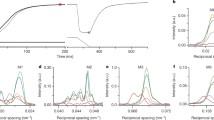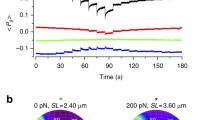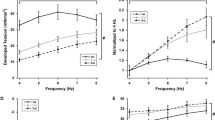Abstract
We have measured the distribution of intracellular calcium concentration in isolated single muscle fibres fromXenopus laevis using the fluorescent calcium indicator fura-2 with digital imaging fluorescence microscopy. Under control conditions, resting and tetanic calcium were uniform throughout a fibre. When fatigue was produced using a prolonged, high-frequency tetanus, the distribution of calcium within muscle fibres became non-uniform, with greater levels near the outer parts of a fibre than near the centre. This non-uniform distribution of calcium was rapidly abolished by lowering the stimulation frequency. When fatigue was produced using a series of repeated intermittent tetani, tetanic calcium showed an initial small increase, followed by a decrease as stimulation was continued. The distribution of calcium remained uniform under these conditions. Calcium distribution was also uniform during recovery from intermittent tetanic stimulation. Although fibres varied considerably in their fatigue resistance, the time for tension to fall to 50% was correlated with the reduction in tetanic calcium seen at this time. These results indicate that there are at least two patterns of reduced calcium release that can contribute to the development of fatigue. The appearance of a calcium gradient is consistent with impaired t-tubular conduction, while a uniform reduction of calcium is likely to be due to the action of metabolic factors on systems controlling calcium homeostasis within the cell.
Similar content being viewed by others
References
Allen DG, Lee JA, Westerblad H (1989a) Intracellular calcium and tension during fatigue in isolated single muscle fibres fromXenopus laevis. J Physiol 415:433–458
Allen DG, Bolsover SR, Lamb A, Lee JA, Silver RA, Westerblad H (1989b) Gradients of intracellular calcium during fatigue in isolated single muscle fibres fromXenopus laevis. J. Physiol 415:120P
Bezanilla F, Caputo C, Gonzalez-Serratos H, Venosa RA (1972) Sodium dependence of inward spread of activation in isolated twitch muscle fibres of the frog. J Physiol 223:507–523
Bigland-Ritchie B, Woods JJ (1984) Changes in muscle contractile properties and neural conrol during human muscular fatigue. Muscle Nerve 7:691–699
Cooke R, Pate E (1985) The effects of ADP and phosphate on the contraction of muscle fibres. Biophys J 48:789–798
Dawson MJ, Gadian DG, Wilkie DR (1980) Mechanical relaxation rate and metabolism studied in fatiguing muscle by phosphorus nuclear magnetic resonance. J Physiol 299:465–484
Eberstein A, Sandow A (1963) Fatigue mechanisms in muscle fibres. In: Gutmann E, Hnik P (eds) The effect of use and disuse on neuromuscular functions. Elsevier. Amsterdam, pp 516–526
Edwards RHT, Hill DK, Jones DA, Merton PA (1977) Fatigue of long duration in human skeletal muscle after exercise. J Physiol 272:769–778
Fabiato A, Fabiato F (1978) Effects of pH on the myofilaments and the sarcoplasmic reticulum of skinned cells from cardiac and skeletal muscles. J Physiol 276:233–255
Godt RE, Nosek TM (1989) Changes of intracellular milieu with fatigue or hypoxia depress contraction of skinned rabbit skeletal and cardiac muscle. J Physiol 412:155–180
Gonzalez-Serratos H, Somlyo A, McClellan G, Shuman H, Borrero LM, Somlyo AP (1978) Composition of vacuoles and sarcoplasmic reticulum in fatigued muscle: electron probe analysis. Proc Natl Acad Sci USA 75:1329–1333
Grabowski W, Lobsiger EA, Luttgau HC (1972) The effect of repetitive stimulation at low frequencies upon the electrical and mechanical activity of single muscle fibres. Pflügers Arch 334:222–239
Grynkiewicz G, Poenie M, Tsien RY (1985) A new generation of Ca2+ indicators with greatly improved fluorescence properties. J Biol Chem 260:3440–3450
Jones DA, Bigland-Ritchie B, Edwards RHT (1979) Excitation frequency and muscle fatigue: mechanical responses during voluntary and stimulated contractions. Exp Neurol 64:401–413
Kentish JC (1986) The effects of inorganic phosphate and creatine phosphate on force production in skinned muscles from rat ventricle. J Physiol 370:585–604
Konishi M, Oison A, Hollingworth S, Baylor SM (1988) Myoplasm binding of fura-2 investigated by steady-state fluorescence and absorbance measurements. Biophys J 54:1089–1104
Kushmerick MJ, Meyer RA (1985) Chemical changes in rat leg muscle by phosphorus nuclear magnetic resonance. Am J Physiol 248:C542–549
Lännergren J, Smith RS (1966) Types of muscle fibres in toad skeletal muscle. Acta Physiol Scand 68:263–274
Lännergren J, Westerblad H (1989) Maximum tension and forcevelocity properties of fatigued, singleXenopus muscle fibres studied by caffeine and high K+. J Physiol 409:473–490
Ma J, Fill M, Knudson CM, Campbell KP (1988) Ryanodine receptor of skeletal muscle is gap junction type channel. Science 242:99–102
Nakajima S, Nakajima Y, Peachey LD (1973) Speed of repolarisation and morphology of glycerol-treated frog muscle fibres. J Physiol 234:465–480
Rousseau E, LaDine, Liu Q-Y, Meissner G (1988) Activation of the calcium release channel of skeletal muscle sarcoplasmic reticulum by caffeine and related compounds. Arch Biochem Biophys 267:75–86
Silver RA, Lamb AG, Bolsover SR (1989) Elevated cytosolic calcium in the growth cone inhibits neurite elongation in neuroblastoma cells: correlation of behavioural states with cytosolic calcium concentration. J Neurosci 9:4007–4020
Smith JS, Coronado R, Meissner G (1985) Sarcoplasmic reticulum contains adenine nucleotide-activated calcium channels. Nature 316:446–449
Van der Laarse WJ, Lammertse TS, Zaremba R, Elzinga G (1989) Some metabolite contents of fatigued, single fast twitch muscle fibres fromXenopus laevis. J Muscle Res Cell Motil (in press)
Westerblad H, Lännergren J (1986) Force and membrane potential during and after fatiguing, intermittent tetanic stimulation of singleXenopus muscle fibres. Acta Physiol Scand 128:369–378
Williams DA, Fogarty KE, Tsien RY, Fay FS (1985) Calcium gradients in single smooth muscle cells revealed by the digital imaging microscope using fura-2. Nature 318:558–561
Author information
Authors and Affiliations
Rights and permissions
About this article
Cite this article
Westerblad, H., Lee, J.A., Lamb, A.G. et al. Spatial gradients of intracellular calcium in skeletal muscle during fatigue. Pflugers Arch. 415, 734–740 (1990). https://doi.org/10.1007/BF02584013
Received:
Revised:
Accepted:
Issue Date:
DOI: https://doi.org/10.1007/BF02584013




